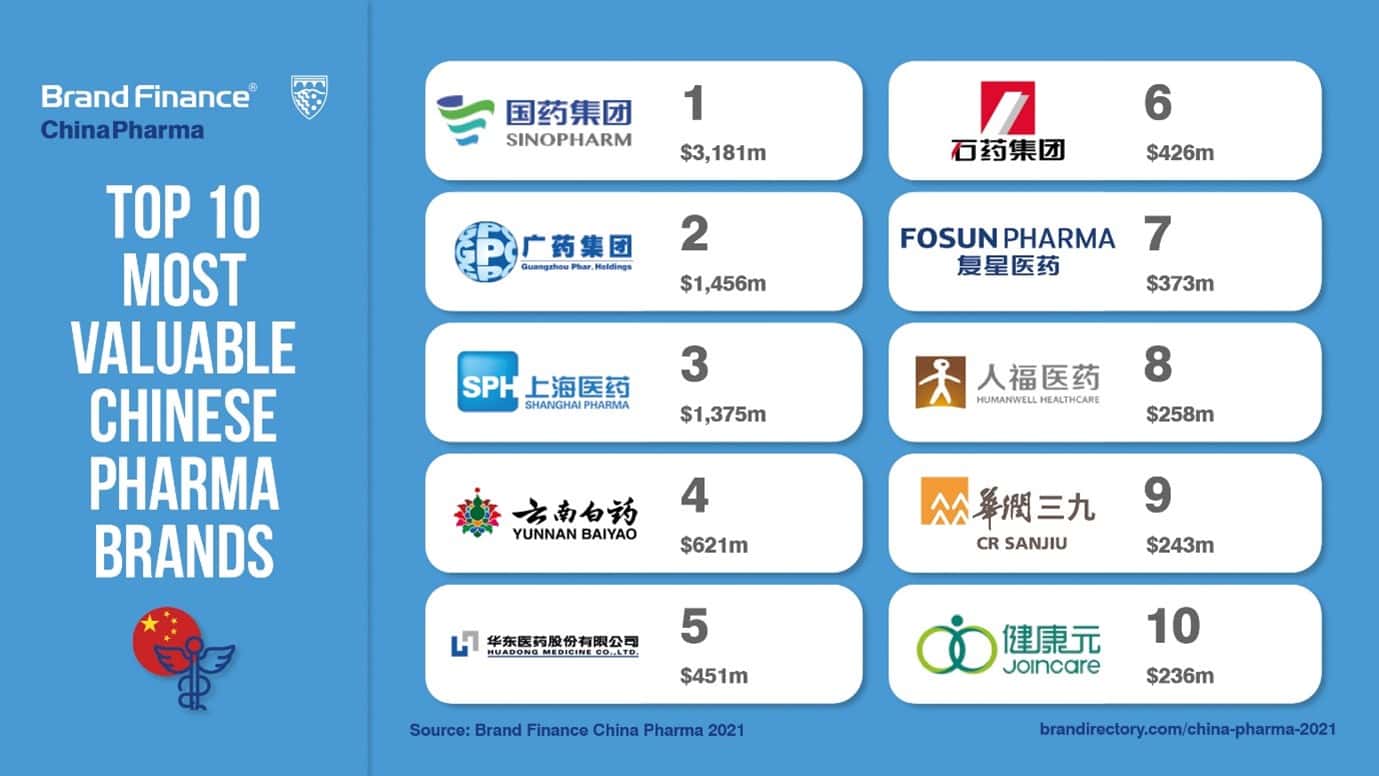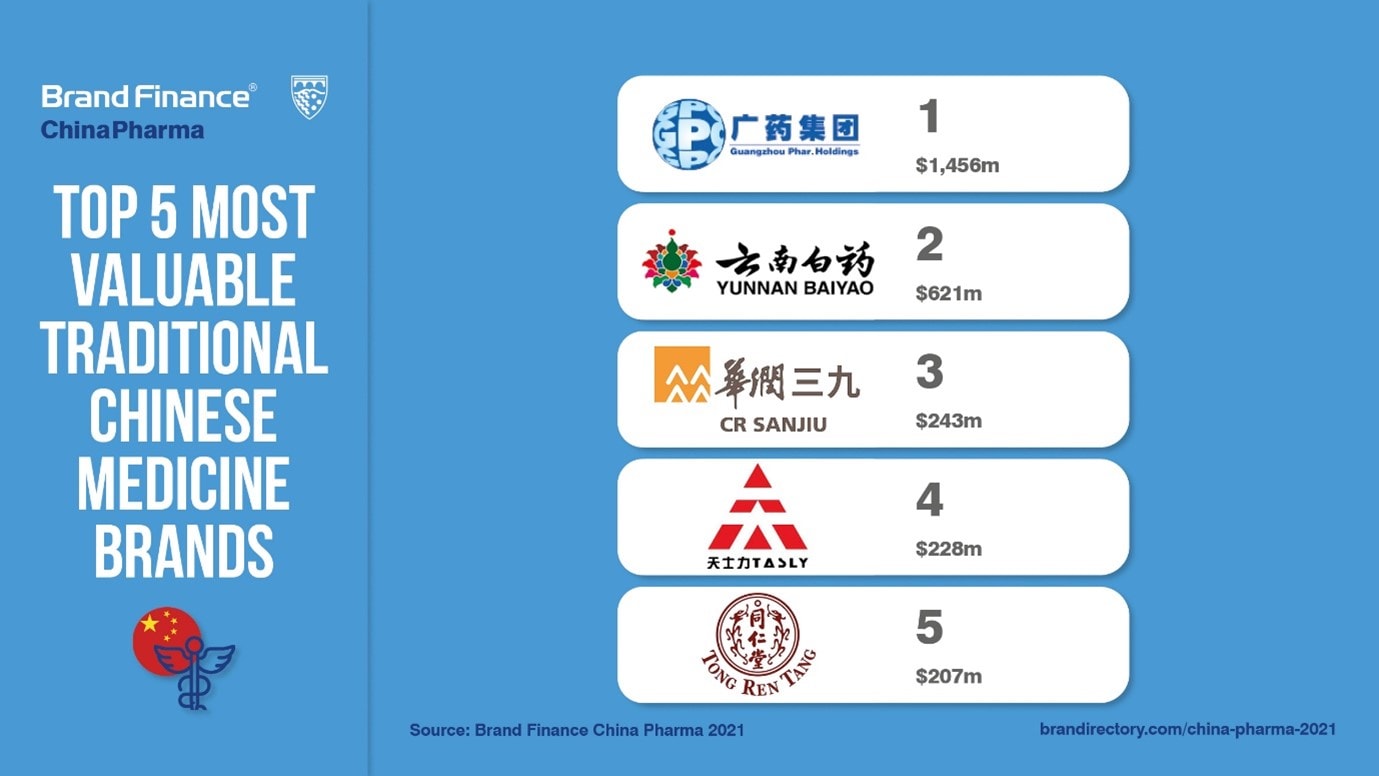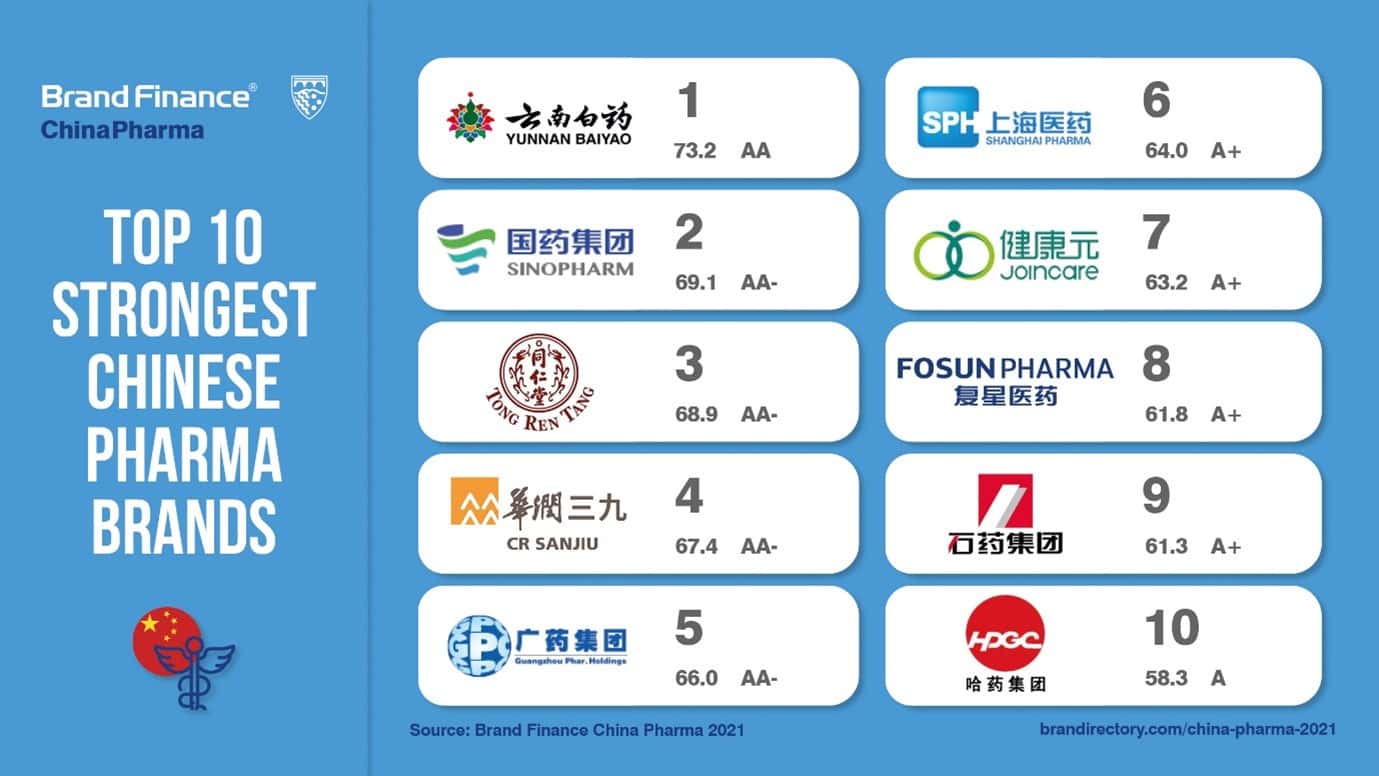View the full Brand Finance Chinese Pharma 2021 report here
Leading the fight against the nation’s health emergency, Chinese pharma brands have performed extremely well over the previous year. According to the Brand Finance China 500 2021 ranking, the pharma sector recorded an impressive 123% cumulative brand value increase – a result bolstered by solid performances across the board, as well as from the eight new brands that entered the ranking this year. Furthermore, four of these brands feature in the Brand Finance Pharma 25 2021 ranking – a ranking of the world’s top 25 most valuable and strongest pharma brands - Sinopharm, Guangzhou Pharmaceuticals Corporation, SPH and, Yunnan Baiyao.
Now, for the first time Brand Finance has ranked the top 15 most valuable and strongest Chinese pharma brands.
Scott Chen, Managing Director, Brand Finance China, commented:
“There is no denying the importance of the role of Chinese pharma brands over the previous year as they spearheaded the fight against the nation’s health emergency and their operations were propelled to the centre of society like never before. This newly-released ranking of the top 15 most valuable and strongest Chinese pharma brands demonstrates the true strength of the sector, with extremely positive results recorded across the board.”
Vaccine development reaps benefits for Sinopharm
Topping the new ranking of China’s most valuable pharma brands is Sinopharm, which has recorded a 58% brand value increase to US$3.2 billion. Sinopharm is making major strides in the global race to produce COVID-19 vaccinations and has since developed a vaccine with a high efficacy rate, which has already been distributed to millions worldwide.
GPC sits in 2nd
Sitting in second is Guangzhou Pharmaceuticals Corporation, boasting a 74% increase in brand value to US$1.5 billion. GPC - one of China’s largest drug makers – has recently entered a partnership with PepsiCo to jointly develop healthy oatmeal products. Furthermore, as one of the top Chinese medicine manufacturers, GPC has been making significant developments by contributing its knowledge of the traditional Chinese medicine – Banlangen – towards controlling the pandemic.
SPH completes podium
Completing the podium in 3rd spot is SPH (brand value up 50% to US$1.4 billion). The brand prides itself on being a leader for research and development across the industry, spending US$194.9 million on research in 2019 alone.
SPH has placed itself in a strong position to reap the rewards of the pandemic-induced shift away from traditional healthcare towards the online and technological side of the sector, through recently securing funding for its online prescription and pharmacy businesses. This funding will also allow the brand to consolidate its network of hospital-centred Chinese pharmacies.

Top 5 traditional Chinese medicine brands
GPC is most valuable traditional Chinese medicine brand
Brand Finance has also created a sub ranking from the Chinese pharma ranking for traditional Chinese medicines brands, given their rise in popularity in recent years.
GPC claims the top spot in this ranking, with Yunnan Baiyao sitting in 2nd. 999 claims third position, following a 50% brand value increase to US$243 million. 999 has recently entered a partnership with insurance giant Ping An, enabling users to directly enjoy 999 Ganmaoling Granules through the Ping An Health app.
Tasly (brand value US$228 million) and Tong Ren Tang (brand value US$207 million) round off the top 5 in 4th and 5th positions, respectively. Tasly continues to focus heavily on R&D and innovation across its operations - the company currently has 75 research projects, 38 category 1 innovative drugs, as well as 46 that have entered the clinical research stage.

Yunnan Baiyao is the strongest Chinese pharma brand
In addition to measuring overall brand value, Brand Finance also determines the relative strength of brands through a balanced scorecard of metrics evaluating marketing investment, stakeholder equity, and business performance.
Brand Finance also conducted original market research on the Chinese pharma sector, where 1000 respondents were asked about the 15 Chinese pharma brands that feature in the ranking and their opinions on a variety of metrics including reputation, recommendation, and trust.
Results from the market research directly funnel into the Brand Strength Index and therefore the responses impact how brands perform in terms of brand strength.
Yunnan Baiyao is the strongest Chinese pharma brand with a Brand Strength Index (BSI) score of 73.2 out of 100 and a corresponding AA brand strength rating. Sinopharm (BSI 69.1), Tong Ren Tang (BSI 68.9), 999 (BSI 67.4) and GPC (BSI 66.0) round off the top 5 for brand strength.
Brand Image
Quality
Overall, brands scored well and generally received high scores for quality. Yunnan Baiyao and Tong Ren Tang ranked first, both scoring 4.2 out of 5, followed by GPC and Baiyunshan scoring 4.0 out of 5. Some consumers have complained, however, about Tong Ren Tang using its brand to increase profits, by developing and selling irrelevant products, which may bring complications to its branded products in the future.
In general, respondents from the older age group tend to give higher quality scores to brands, compared with the lower two age categories. This is not the case for Sinopharm, which has higher quality perceptions (4.0/5.0) among the younger age group of respondents (18-34), a score higher than the mid-age group (35-54)’s perceptions at 3.9 and the older age group (55-75)’s result at 3.8. This is potentially the result of the younger generation having more trust in the COVID-19 vaccination than their older counterparts.
Closeness
Humanwell performs strongly in the 18-34 age group (7.0/10) compared with the two older age groups (35-54 and 55-75), scoring 6.3 and 6.8 out 10, respectively. This is predominantly due to the popularity of its women’s health products, as a leading brand in fertility space.
Genuinely offer something different
Yunnan Baiyao and Joincare pharma rank first in this measure due to their unique product offering in the market. For example, Baiyao series products are exclusive to Yunnan Baiyao and the formula remains a nationwide top secret. Its core variations have been selected into the National Medical Insurance Class A drug catalogue for many years.
Positive perceptions around profits versus costumer well-being
Respondents in general do not think that Chinese pharma brands care more about profits than their customers. This is largely due to the medicine regulation in China, as well as the increasing availability of public health insurance.
Good product range
The top three pharma brands - Sinopharm, SPH and GPC rank top in this measure, with scores of 49%, 51%, and 44% respectively. GPC also benefits from producing both Western medicine and traditional Chinese medicine, unlike the other two which largely focus on Western medicine.
Brand Funnels
Awareness: Yunnan Baiyao leads, scoring impressive 97% across all age groups
Yunnan Baiyao boasts the highest awareness score (97%) across all three age groups, followed by Tong Ren Tang (94%). Humanwell performs worst (23%) among all three age groups.
The three biggest pharma groups researched - Sinopharm, SPH, and GPC - scored 85%, 56%, and 63% respectively. Sinopharm’s contribution to the Covid vaccine race has propelled it to become a household name across the nation.
Some brands, such as CSPC, have a strong regional focus and presence. It scored 79% in Jinan and 72% in Beijing in northern China, but did not perform well in the southern provinces. The same trend is witnessed with Tasly. Trends like this are often the result of brands simply not reaching awareness levels on a national scale yet and therefore they naturally fall behind the sector leaders Sinopharm, SPH, and GPC in this metric.
Familiarity: Once again Yunnan Baiyao leads pack
The familiarity metric follows a similar trend to the awareness metric, with Yunnan Baiyao ranking first (67%) among all three-age group respondents, followed by Tong Ren Tang (63%). Sinopharm and Bai Yun Shan also perform well, scoring 45% and 41% respectively.
Humanwell Healthcare, Tasly, and Joincare Pharma score the lowest – ranging from a 5% to 10% familiarity level, largely a result of their limited consumer-facing branded product range.
Consideration: Yunnan Baiyao and Tong Ren Tang score 99% and 98% respectively
Among those who are familiar with the Yunnan Baiyao and Tong Ren Tang brands, 99% and 98% would consider choosing to use their products. Sinopharm, SPH, 999, Harbin Pharmaceutical, and GPC also boast high consideration scores (all over 90%).
GPC own products that consumers use in their everyday lives – such as Wanglaoji and Banlangen granules – therefore earning them a high consideration score. GPC is also the largest manufacturer in China for digestible antibiotics, owning the first brand of digestible antibiotics, Kangzhiba. Furthermore, its leading product cefathiamidine is currently the only cephalosporin developed by the Chinese themselves.
Reputation Versus Recommendation
Reputation
GPC scores 7.7. Brands within the GPC group including Chenliji and Wanglaoji have a long history and products from these brands including Banlangeng and xiaocaihu granules have played an important role in fighting the pandemic, therefore contributing to the strong reputation score.
The average score in the traditional Chinese medicine group is 7.8, which is higher than the Western medicine group at 7.5, demonstrating that generally traditional medicine has a higher reputation due to its history and culture accumulation.
Sinopharm ranks top in the Western medicine group with a score of 8.0. Sinopharm owns over 1,100 subsidiaries as well as six listed companies and has built a nationwide logistic and distributing network for providing quality service to more than 230,000 corporate clients.
Recommendation
Yunnan Baiyao and Tong Ren Tang rank joint first with a score of 8.3 out of 10. GPC also boasts a high recommendation score of 7.8. Ten traditional Chinese medicines from the GPC group were selected for use in the diagnosis and treatment of Covid by the government, showcasing strong endorsement of GPC products.
Sinopharm and Fosun Pharma are the only two brands with a recommendation score higher than 8 out of 10 in the Western medicine group. Fosun Pharma has recently won a new partnership with BioNTech – German biotechnology company behind the globally known Pfizer–BioNTech Covid vaccine - and is commercialising its mRNA technology in producing vaccine products across China.
Buchang Pharma surprisingly performs best among the 18-34 age group with a score of 8.5 for recommendation. The company is focusing on the modernisation of traditional Chinese medicine, explaining its popularity among the younger age category.

View the full Brand Finance Chinese Pharma 2021 report here
ENDS
Note to Editors
Every year, Brand Finance puts 5,000 of the biggest brands to the test, evaluating their strength and quantifying their value, and publishes nearly 100 reports, ranking brands across all sectors and countries. The top 15 most valuable Chinese pharma most valuable and strongest brands are included in the Brand Finance Chinese Pharma 2021 report here.
The full Brand Finance China 500 2021 ranking, additional insights, charts, more information about the methodology, as well as definitions of key terms are available in the Brand Finance Chinese Pharma 2021 report here.
Brand value is understood as the net economic benefit that a brand owner would achieve by licensing the brand in the open market. Brand strength is the efficacy of a brand’s performance on intangible measures relative to its competitors. Please see below for a full explanation of our methodology.
About Brand Finance
Brand Finance is the world’s leading brand valuation consultancy. Bridging the gap between marketing and finance, Brand Finance evaluates the strength of brands and quantifies their financial value to help organisations of all kinds make strategic decisions.
Headquartered in London, Brand Finance has offices in over 20 countries, offering services on all continents. Every year, Brand Finance conducts more than 5,000 brand valuations, supported by original market research, and publishes nearly 100 reports which rank brands across all sectors and countries.
Brand Finance is a regulated accountancy firm, leading the standardisation of the brand valuation industry. Brand Finance was the first to be certified by independent auditors as compliant with both ISO 10668 and ISO 20671, and has received the official endorsement of the Marketing Accountability Standards Board (MASB) in the United States.
Methodology
Definition of Brand
Brand is defined as a marketing-related intangible asset including, but not limited to, names, terms, signs, symbols, logos, and designs, intended to identify goods, services, or entities, creating distinctive images and associations in the minds of stakeholders, thereby generating economic benefits.
Brand Value
Brand value refers to the present value of earnings specifically related to brand reputation. Organisations own and control these earnings by owning trademark rights.
All brand valuation methodologies are essentially trying to identify this, although the approach and assumptions differ. As a result, published brand values can be different.
These differences are similar to the way equity analysts provide business valuations that are different to one another. The only way you find out the “real” value is by looking at what people really pay.
As a result, Brand Finance always incorporates a review of what users of brands actually pay for the use of brands in the form of brand royalty agreements, which are found in more or less every sector in the world.
This is known as the “Royalty Relief” methodology and is by far the most widely used approach for brand valuations since it is grounded in reality.
It is the basis for our public rankings but we always augment it with a real understanding of people’s perceptions and their effects on demand – from our database of market research on over 3000 brands in over 30 markets.
Brand Valuation Methodology
For our rankings, Brand Finance uses the simplest method possible to help readers understand, gain trust in, and actively use brand valuations.
Brand Finance calculates the values of brands in its rankings using the Royalty Relief approach – a brand valuation method compliant with the industry standards set in ISO 10668.
Our Brand Strength Index assessment, a balanced scorecard of brand-related measures, is also compliant with international standards (ISO 20671) and operates as a predictive tool of future brand value changes and a control panel to help business improving marketing.
We do this in the following four steps:
1. Brand Impact
We review what brands already pay in royalty agreements. This is augmented by an analysis of how brands impact profitability in the sector versus generic brands.
This results in a range of possible royalties that could be charged in the sector for brands (for example a range of 0% to 2% of revenue).
2. Brand Strength
We adjust the rate higher or lower for brands by analysing Brand Strength. We analyse brand strength by looking at three core pillars: “Investment” which are activities supporting the future strength of the brand; “Equity” which are real perceptions sourced from our original market research and other data partners; “Performance” which are brand-related measures of business results, such as market share.
Each brand is assigned a Brand Strength Index (BSI) score out of 100, which feeds into the brand value calculation. Based on the score, each brand is assigned a corresponding Brand Rating up to AAA+, in a format similar to a credit rating.
3. Brand Impact x Brand Strength
The BSI score is applied to the royalty range to arrive at a royalty rate. For example, if the royalty range in a sector is 0-5% and a brand has a BSI score of 80 out of 100, then an appropriate royalty rate for the use of this brand in the given sector will be 4%.
4. Brand Value Calculation
We determine brand-specific revenues as a proportion of parent company revenues attributable to the brand in question and forecast those revenues by analysing historic revenues, equity analyst forecasts, and economic growth rates.
We then apply the royalty rate to the forecast revenues to derive brand revenues and apply the relevant valuation assumptions to arrive at a discounted, post-tax present value which equals the brand value.
Disclaimer
Brand Finance has produced this study with an independent and unbiased analysis. The values derived and opinions presented in this study are based on publicly available information and certain assumptions that Brand Finance used where such data was deficient or unclear. Brand Finance accepts no responsibility and will not be liable in the event that the publicly available information relied upon is subsequently found to be inaccurate. The opinions and financial analysis expressed in the study are not to be construed as providing investment or business advice. Brand Finance does not intend the study to be relied upon for any reason and excludes all liability to any body, government, or organisation.
The data presented in this study form part of Brand Finance's proprietary database, are provided for the benefit of the media, and are not to be used in part or in full for any commercial or technical purpose without written permission from Brand Finance.